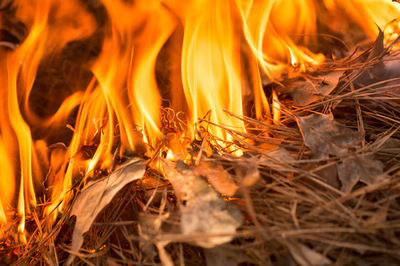Wisconsin Experiencing High Fire Danger; Residents Asked to Avoid Burning
Tuesday, April 15th, 2025 -- 8:00 AM

Elevated fire danger resulted in 63 wildfires burning 135 acres this past weekend, and the Wisconsin Department of Natural Resources (DNR) is continuing to suspend burn permits in 24 counties where the DNR has burn restriction authority as fire danger remains "high" and "very high" in many areas of the state.
The dry weather and very high winds forecasted through this Wednesday significantly increase fire risk across the state to start the week. Along with burning permit restrictions, the DNR will be staffing all available fire equipment across the state and shifting resources to areas with elevated fire risk.
An incident management team is on standby to mobilize in the event a large fire ignites. The Wisconsin Army National Guard will also have two crews available to respond with Blackhawk helicopters with bucket capability.
Spring is the most critical fire season in Wisconsin. Shortly after the snow disappears, a dry spring or even a few days in between precipitation can leave grasses, pine needles and leaf litter very dry, creating hazardous conditions.
Warmer temperatures, low humidity and windy days, coupled with many landowners conducting spring clean-ups around their property by burning yard waste, lead to the majority of wildfires.
Many people were outside over the weekend cleaning up their yards and choosing to burn debris accumulated over the winter. Others were burning off prairie or grassy areas for habitat management.
If planning to burn, it's important to obtain proper burn permits, check the daily DNR restrictions prior to burning each day, follow the rules on the permit and ensure burns are completely out prior to leaving.
Think Your Fire Is Out? Check Again.
As we continue this dry stretch of weather, remember, even when the flames die down, fires are not necessarily out. This season the DNR has seen an increase in the number of wildfires started from burns not fully extinguished.
Dry, windy stretches like the start of this week mean embers and heavier vegetation (e.g., stumps and logs) can hold heat for days and potentially reignite.
To ensure your fire is completely out, always use lots of water, drown, stir and repeat until cold. The DNR also recommends going back hours after extinguishing and checking again for any remaining smoke or embers.
In 2025, the DNR has responded to nearly 500 wildfires that burned 2,000 areas. Local fire departments have also responded to numerous wildfires. This is almost double the number of fires in a typical year, and 49% of the fires this year have been caused by debris burning.
Remember, fire danger and burning restrictions change every day. Check current fire danger, wildfire reports and burning restrictions on the DNR's website before burning.
Feel free to contact us with questions and/or comments.




